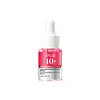What's inside
What's inside
 Key Ingredients
Key Ingredients

 Benefits
Benefits

 Concerns
Concerns

 Ingredients Side-by-side
Ingredients Side-by-side

Water
Skin ConditioningGlycerin
HumectantNiacinamide
SmoothingMethylpropanediol
SolventTranexamic Acid
Astringent1,2-Hexanediol
Skin ConditioningArbutin
AntioxidantSodium Hyaluronate
HumectantXanthan Gum
EmulsifyingEthylhexylglycerin
Skin ConditioningCarbomer
Emulsion StabilisingPotentilla Anserina Extract
Skin ConditioningAmmonium Acryloyldimethyltaurate/Vp Copolymer
Adenosine
Skin ConditioningTromethamine
BufferingPolyquaternium-51
Skin ConditioningAvena Sativa Kernel Extract
AbrasiveCynara Scolymus Leaf Extract
Skin ConditioningBeta-Glucan
Skin ConditioningHydrogenated Lecithin
EmulsifyingCamellia Sinensis Leaf Water
MaskingDisodium EDTA
Alpha-Arbutin
AntioxidantCyanocobalamin
Skin ConditioningLactococcus Ferment Lysate
Skin ConditioningFructooligosaccharides
HumectantButylene Glycol
HumectantCentella Asiatica Extract
CleansingCyperus Rotundus Root Extract
Skin ConditioningTocopherol
AntioxidantMelaleuca Alternifolia Leaf Extract
PerfumingSodium Chloride
MaskingPropanediol
SolventDimethylsilanol Hyaluronate
HumectantHydrolyzed Hyaluronic Acid
HumectantHydrolyzed Sodium Hyaluronate
Skin ConditioningHyaluronic Acid
HumectantPotassium Hyaluronate
Skin ConditioningCeramide NP
Skin ConditioningSodium Hyaluronate Crosspolymer
HumectantHydroxypropyltrimonium Hyaluronate
Sodium Hyaluronate Dimethylsilanol
HumectantSodium Acetylated Hyaluronate
HumectantSucrose Distearate
EmollientCaprylic/Capric Triglyceride
MaskingHydroxypropyl Cyclodextrin
MaskingCentella Asiatica Leaf Extract
Skin ConditioningSaccharomyces Ferment
Skin ConditioningCentella Asiatica Root Extract
Skin ConditioningAsiaticoside
AntioxidantMadecassoside
AntioxidantMadecassic Acid
Skin ConditioningAsiatic Acid
Skin ConditioningWater, Glycerin, Niacinamide, Methylpropanediol, Tranexamic Acid, 1,2-Hexanediol, Arbutin, Sodium Hyaluronate, Xanthan Gum, Ethylhexylglycerin, Carbomer, Potentilla Anserina Extract, Ammonium Acryloyldimethyltaurate/Vp Copolymer, Adenosine, Tromethamine, Polyquaternium-51, Avena Sativa Kernel Extract, Cynara Scolymus Leaf Extract, Beta-Glucan, Hydrogenated Lecithin, Camellia Sinensis Leaf Water, Disodium EDTA, Alpha-Arbutin, Cyanocobalamin, Lactococcus Ferment Lysate, Fructooligosaccharides, Butylene Glycol, Centella Asiatica Extract, Cyperus Rotundus Root Extract, Tocopherol, Melaleuca Alternifolia Leaf Extract, Sodium Chloride, Propanediol, Dimethylsilanol Hyaluronate, Hydrolyzed Hyaluronic Acid, Hydrolyzed Sodium Hyaluronate, Hyaluronic Acid, Potassium Hyaluronate, Ceramide NP, Sodium Hyaluronate Crosspolymer, Hydroxypropyltrimonium Hyaluronate, Sodium Hyaluronate Dimethylsilanol, Sodium Acetylated Hyaluronate, Sucrose Distearate, Caprylic/Capric Triglyceride, Hydroxypropyl Cyclodextrin, Centella Asiatica Leaf Extract, Saccharomyces Ferment, Centella Asiatica Root Extract, Asiaticoside, Madecassoside, Madecassic Acid, Asiatic Acid
Water
Skin ConditioningAvena Sativa Kernel Extract
AbrasiveTranexamic Acid
AstringentDimethyl Isosorbide
SolventMandelic Acid
AntimicrobialEthoxydiglycol
HumectantPentylene Glycol
Skin ConditioningMethylpropanediol
SolventAcetyl Glucosamine
Skin ConditioningHydroxyphenoxy Propionic Acid
Skin ConditioningSodium Hyaluronate
HumectantSalicylic Acid
MaskingXanthan Gum
EmulsifyingLecithin
EmollientPhenoxyethanol
PreservativeSclerotium Gum
Emulsion StabilisingPullulan
Ethylhexylglycerin
Skin ConditioningCurcuma Longa Root Extract
MaskingTrisodium Ethylenediamine Disuccinate
Water, Avena Sativa Kernel Extract, Tranexamic Acid, Dimethyl Isosorbide, Mandelic Acid, Ethoxydiglycol, Pentylene Glycol, Methylpropanediol, Acetyl Glucosamine, Hydroxyphenoxy Propionic Acid, Sodium Hyaluronate, Salicylic Acid, Xanthan Gum, Lecithin, Phenoxyethanol, Sclerotium Gum, Pullulan, Ethylhexylglycerin, Curcuma Longa Root Extract, Trisodium Ethylenediamine Disuccinate
 Reviews
Reviews

Ingredients Explained
These ingredients are found in both products.
Ingredients higher up in an ingredient list are typically present in a larger amount.
Avena Sativa Kernel Extract is is derived from colloidal oatmeal. Besides being a healthy breakfast, oats have many benefits in skincare too.
This ingredient helps sooth, hydrate, and protect the skin. The starches in colloidal oatmeal are able to bind water, keeping the skin hydrated.
The cellulose and fiber in colloidal oatmeal help reduce inflammation. This can also help the skin feel softer.
Colloidal Oatmeal is also an antioxidant. Antioxidants protect our skin from free-radical damage.
Oatmeal also contains beneficial compounds:
This ingredient is created by mixing grounded oatmeal and a liquid base.
Learn more about Avena Sativa Kernel ExtractEthylhexylglycerin (we can't pronounce this either) is commonly used as a preservative and skin softener. It is derived from glyceryl.
You might see Ethylhexylglycerin often paired with other preservatives such as phenoxyethanol. Ethylhexylglycerin has been found to increase the effectiveness of these other preservatives.
Methylpropanediol is a synthetic solvent and humectant.
As a solvent, it helps dissolve other ingredients, helping to evenly distribute ingredients throughout the product. This ingredient has also been shown to have antimicrobial properties which makes it a preservative booster.
Methylpropanediol is able to add a bit of moisture to the skin. It also helps other ingredients be better absorbed into the skin, such as salicylic acid.
Learn more about MethylpropanediolSodium Hyaluronate is hyaluronic acid's salt form. It is commonly derived from the sodium salt of hyaluronic acid.
Like hyaluronic acid, it is great at holding water and acts as a humectant. This makes it a great skin hydrating ingredient.
Sodium Hyaluronate is naturally occurring in our bodies and is mostly found in eye fluid and joints.
These are some other common types of Hyaluronic Acid:
Learn more about Sodium HyaluronateTranexamic Acid is best used for treating hyperpigmentation, discoloration, and melasma. It can also help build a stronger skin barrier.
Once applied, Tranexamic Acid starts decreasing inflammation from UV exposure. Tranexamic Acid also prevents our skin cells from meeting the pigment production cells.
Its brightening property makes it great at reducing the appearance of acne scars and marks.
Fun fact: Tranexamic Acid is also a medication used to reduce heavy bleeding.
This acid is derived from lysine, an amino acid.
Learn more about Tranexamic AcidWater. It's the most common cosmetic ingredient of all. You'll usually see it at the top of ingredient lists, meaning that it makes up the largest part of the product.
So why is it so popular? Water most often acts as a solvent - this means that it helps dissolve other ingredients into the formulation.
You'll also recognize water as that liquid we all need to stay alive. If you see this, drink a glass of water. Stay hydrated!
Learn more about WaterXanthan gum is used as a stabilizer and thickener within cosmetic products. It helps give products a sticky, thick feeling - preventing them from being too runny.
On the technical side of things, xanthan gum is a polysaccharide - a combination consisting of multiple sugar molecules bonded together.
Xanthan gum is a pretty common and great ingredient. It is a natural, non-toxic, non-irritating ingredient that is also commonly used in food products.
Learn more about Xanthan Gum